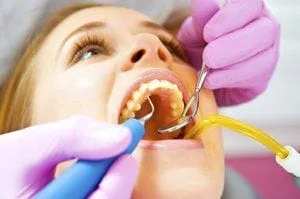Hygiene Services

Intro to Gum Disease
How do we treat Gum Disease?
The first step in dealing with gum disease is identifying it, something our hygienists are very experienced at doing. We find that many adults have active gum disease and some areas of gum recession and bone loss. We identify areas of breakdown, susceptibility, and relative health, and then develop a treatment plan based on the individual’s needs. Our initial goal is to arrest active gum disease and establish stability, so you aren’t losing any ground. This is done by e liminating the bad microbes, thoroughly removing accumulated irritants, coaching you on daily cleaning techniques, and assessing individual risk factors.
The most important part of gum disease treatment and control is elimination of the harmful microbes that are always driving the infection. Traditional gum disease treatment protocols involve the common use of pharmaceutical antibiotics, either systemic or locally placed in the gum tissues. All these drugs come with precautions, limitations, and side effects. We are now using a naturally occurring substance that kills bacteria, viruses, and parasites, without toxicity or side effects. That substance is oxygen and its energized form, ozone . Ozone therapy is utilized orally through its three application forms: ozonated water, oxygen/ozone gas, and ozonated olive oil.
Thorough removal of all biofilm and calcified deposits from above and below the gumline is achieved through a method called scaling and root planing or a “deep cleaning ”, and is critical for gum healing. We use a combination of specially designed hand instruments and ultrasonic cleaning instruments to achieve this removal, often over several appointments. We may also use a low power gum laser which kills harmful bacteria and energizes the cells that play leading roles in the healing process.
An additional tool that is very helpful in identifying the presence of particularly destructive bacteria is oral DNA testing . This can be especially helpful when gum disease remains active in spite of all efforts to control it. We collect a small saliva sample and send it to a special lab that identifies the types of bateria present and their relative numbers. They have another test that can identify if the patient has a genetic tendency or predisposition to gum disease. This can be very helpful knowledge when helping someone whose gum disease remains stubbornly active.
In some cases we may refer you to a gum specialist, also known as a Periodontist, for treatment of advanced gum disease or for specific problems.
Can Gum Disease be reversed? Will bone grow back?
Gum Disease cannot be reversed, meaning bone and gums that have been lost will not grow back. Our goals, through continued professional care in our office, are to arrest active gum disease, to halt active bone loss, to stabilize and maintain bone levels around all teeth and roots, and to prevent tooth loss. Another equally important goal is to show patients what has been happening with their gums and to teach and coach them to properly care for their own oral health.
Periodontists may use special techniques such as bone grafts, gum grafts, or other surgical procedures to regain bone and gum levels in specific problem areas .
